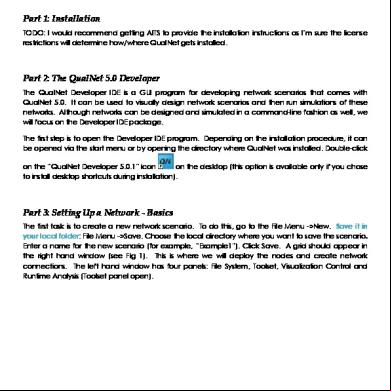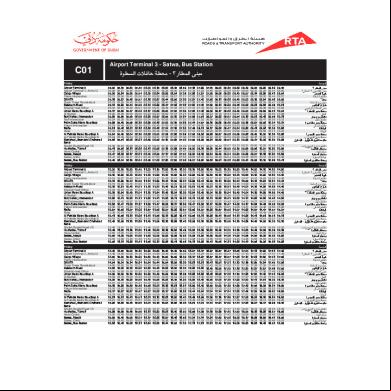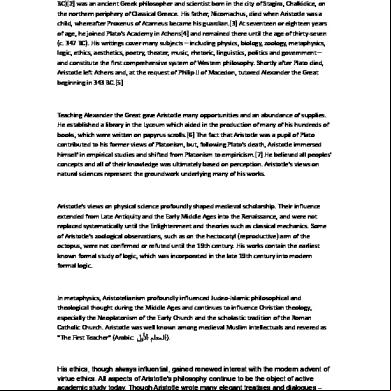Qualnet Simulator 481v4c
This document was ed by and they confirmed that they have the permission to share it. If you are author or own the copyright of this book, please report to us by using this report form. Report 3i3n4
Overview 26281t
& View Qualnet Simulator as PDF for free.
More details 6y5l6z
- Words: 848
- Pages: 12
BY GEORGE RAHUL PAUL
Brain Child OF ?
QualNet The QualNet® communications simulation platform (QualNet) is a planning, testing and training tool that "mimics" the behavior of a real communications network. Simulation is a cost-effective method for developing, deploying and managing network-centric systems throughout their entire lifecycle. s can evaluate the basic behavior of a network, and test combinations of network features that are likely to work. QualNet provides a comprehensive environment for deg protocols, creating and animating network scenarios, and analyzing their performance.
QualNet is composed of the following components:
QualNet Architect — A graphical scenario design and visualization tool. In Design mode, you can set up terrain, network connections, subnets, mobility patterns of wireless s, and other functional parameters of network nodes. You can create network models by using intuitive, click and drag operations. You can also customize the protocol stack of any of the nodes. You can also specify the application layer traffic and services that run on the network. In Visualize mode, you can perform indepth visualization and analysis of a network scenario designed in Design mode. As simulations are running, s can watch packets at various layers flow through the network and view dynamic graphs of critical performance metrics. Real-time statistics are also an option, where you can view dynamic graphs while a network scenario simulation is running.
QualNet Analyzer — A statistical graphing tool that displays hundreds of metrics collected during simulation of a network scenario. You can choose to see pre-designed reports or customize graphs with their own statistics. Multi-experiment reports are also available. All statistics are exportable to spreadsheets in CSV format.
QualNet Packet Tracer — A graphical tool that provides a visual representation of packet trace files generated during the simulation of a network scenario. Trace files are text files in XML format that contain information about packets as they move up and down the protocol stack.
QualNet File Editor — A text editing tool
QualNet Command Line Interface — Command line access to the simulator
QualNet enables s to:
Design new protocol models
Optimize new and existing models
Design large wired and wireless networks using pre-configured or -designed models
Analyze the performance of networks and perform what-if analysis to optimize them
Key features of QualNet Speed
QualNet can real-time speed to enable software-in-the-loop, network emulation, and human-in-the-loop modeling. Faster speed enables model developers and network designers to run multiple “what-if” analyses by varying model, network, and traffic parameters in a short time.
Scalability
QualNet can model thousands of nodes by taking advantage of the latest hardware and parallel computing techniques. QualNet can run on cluster, multi-core, and multi-processor systems to model large networks with high fidelity.
Model Fidelity
QualNet uses highly detailed standards-based implementation of protocol models. It also includes advanced models for the wireless environment to enable more accurate modeling of real-world networks.
Portability
QualNet and its library of models run on a vast array of platforms, including Windows and Linux operating systems, distributed and cluster parallel architectures, and both 32- and 64-bit computing platforms. s can now develop a protocol model or design a network in QualNet on their desktop or laptop Windows computer and then transfer it to a powerful multi-processor Linux server to run capacity, performance, and scalability analyses.
Extensibility
QualNet can connect to other hardware and software applications, such as OTB, real networks, and third party visualization software, to greatly enhance the value of the network model.
Scenario-Based Communications Simulation In QualNet, a specific network topology is referred to as a scenario. A scenario allows the to specify all the network components and conditions under which the network will operate. This includes: terrain details, channel propagation effects including path loss, fading, and shadowing, wired and wireless subnets, network devices such as switches, hubs and routers, the entire protocol stack of a variety of standard or -configured network components, and applications running on the network. Most of these are optional; you can start with a basic network scenario and specify as much detail as necessary to improve the accuracy of your network model
Cyber Warfare Training
SCALABLE is under contract with STRATCOM to adapt the EXata/Cyber simulation platform to meet some very specific training needs. This cyber training system will enable s to:
Build detailed software virtual networks comprised of both standard routers, switches, hubs, wireless access points, base stations, and mobile s, and customized DoD-specific communications equipment
Control per-layer and per-event animation in 2D and 3D to visualize communications behavior
Leverage extensible libraries that model encryption, authentication, key distribution and certificate management, wormhole attacks, network intrusion, and other adversaries
Learn about eavesdropping, radio jamming attacks, and distributed denial of service (DDoS) attacks
Mix Mode Actual physical elements (live hardware and software, whole networks, etc.) can be integrated with software virtual networks into highly realistic "mixed mode" environments. Developmental or production applications can be run "across" the virtual environment exactly as if it were running over an equivalent physical network.
Thank You
Brain Child OF ?
QualNet The QualNet® communications simulation platform (QualNet) is a planning, testing and training tool that "mimics" the behavior of a real communications network. Simulation is a cost-effective method for developing, deploying and managing network-centric systems throughout their entire lifecycle. s can evaluate the basic behavior of a network, and test combinations of network features that are likely to work. QualNet provides a comprehensive environment for deg protocols, creating and animating network scenarios, and analyzing their performance.
QualNet is composed of the following components:
QualNet Architect — A graphical scenario design and visualization tool. In Design mode, you can set up terrain, network connections, subnets, mobility patterns of wireless s, and other functional parameters of network nodes. You can create network models by using intuitive, click and drag operations. You can also customize the protocol stack of any of the nodes. You can also specify the application layer traffic and services that run on the network. In Visualize mode, you can perform indepth visualization and analysis of a network scenario designed in Design mode. As simulations are running, s can watch packets at various layers flow through the network and view dynamic graphs of critical performance metrics. Real-time statistics are also an option, where you can view dynamic graphs while a network scenario simulation is running.
QualNet Analyzer — A statistical graphing tool that displays hundreds of metrics collected during simulation of a network scenario. You can choose to see pre-designed reports or customize graphs with their own statistics. Multi-experiment reports are also available. All statistics are exportable to spreadsheets in CSV format.
QualNet Packet Tracer — A graphical tool that provides a visual representation of packet trace files generated during the simulation of a network scenario. Trace files are text files in XML format that contain information about packets as they move up and down the protocol stack.
QualNet File Editor — A text editing tool
QualNet Command Line Interface — Command line access to the simulator
QualNet enables s to:
Design new protocol models
Optimize new and existing models
Design large wired and wireless networks using pre-configured or -designed models
Analyze the performance of networks and perform what-if analysis to optimize them
Key features of QualNet Speed
QualNet can real-time speed to enable software-in-the-loop, network emulation, and human-in-the-loop modeling. Faster speed enables model developers and network designers to run multiple “what-if” analyses by varying model, network, and traffic parameters in a short time.
Scalability
QualNet can model thousands of nodes by taking advantage of the latest hardware and parallel computing techniques. QualNet can run on cluster, multi-core, and multi-processor systems to model large networks with high fidelity.
Model Fidelity
QualNet uses highly detailed standards-based implementation of protocol models. It also includes advanced models for the wireless environment to enable more accurate modeling of real-world networks.
Portability
QualNet and its library of models run on a vast array of platforms, including Windows and Linux operating systems, distributed and cluster parallel architectures, and both 32- and 64-bit computing platforms. s can now develop a protocol model or design a network in QualNet on their desktop or laptop Windows computer and then transfer it to a powerful multi-processor Linux server to run capacity, performance, and scalability analyses.
Extensibility
QualNet can connect to other hardware and software applications, such as OTB, real networks, and third party visualization software, to greatly enhance the value of the network model.
Scenario-Based Communications Simulation In QualNet, a specific network topology is referred to as a scenario. A scenario allows the to specify all the network components and conditions under which the network will operate. This includes: terrain details, channel propagation effects including path loss, fading, and shadowing, wired and wireless subnets, network devices such as switches, hubs and routers, the entire protocol stack of a variety of standard or -configured network components, and applications running on the network. Most of these are optional; you can start with a basic network scenario and specify as much detail as necessary to improve the accuracy of your network model
Cyber Warfare Training
SCALABLE is under contract with STRATCOM to adapt the EXata/Cyber simulation platform to meet some very specific training needs. This cyber training system will enable s to:
Build detailed software virtual networks comprised of both standard routers, switches, hubs, wireless access points, base stations, and mobile s, and customized DoD-specific communications equipment
Control per-layer and per-event animation in 2D and 3D to visualize communications behavior
Leverage extensible libraries that model encryption, authentication, key distribution and certificate management, wormhole attacks, network intrusion, and other adversaries
Learn about eavesdropping, radio jamming attacks, and distributed denial of service (DDoS) attacks
Mix Mode Actual physical elements (live hardware and software, whole networks, etc.) can be integrated with software virtual networks into highly realistic "mixed mode" environments. Developmental or production applications can be run "across" the virtual environment exactly as if it were running over an equivalent physical network.
Thank You










